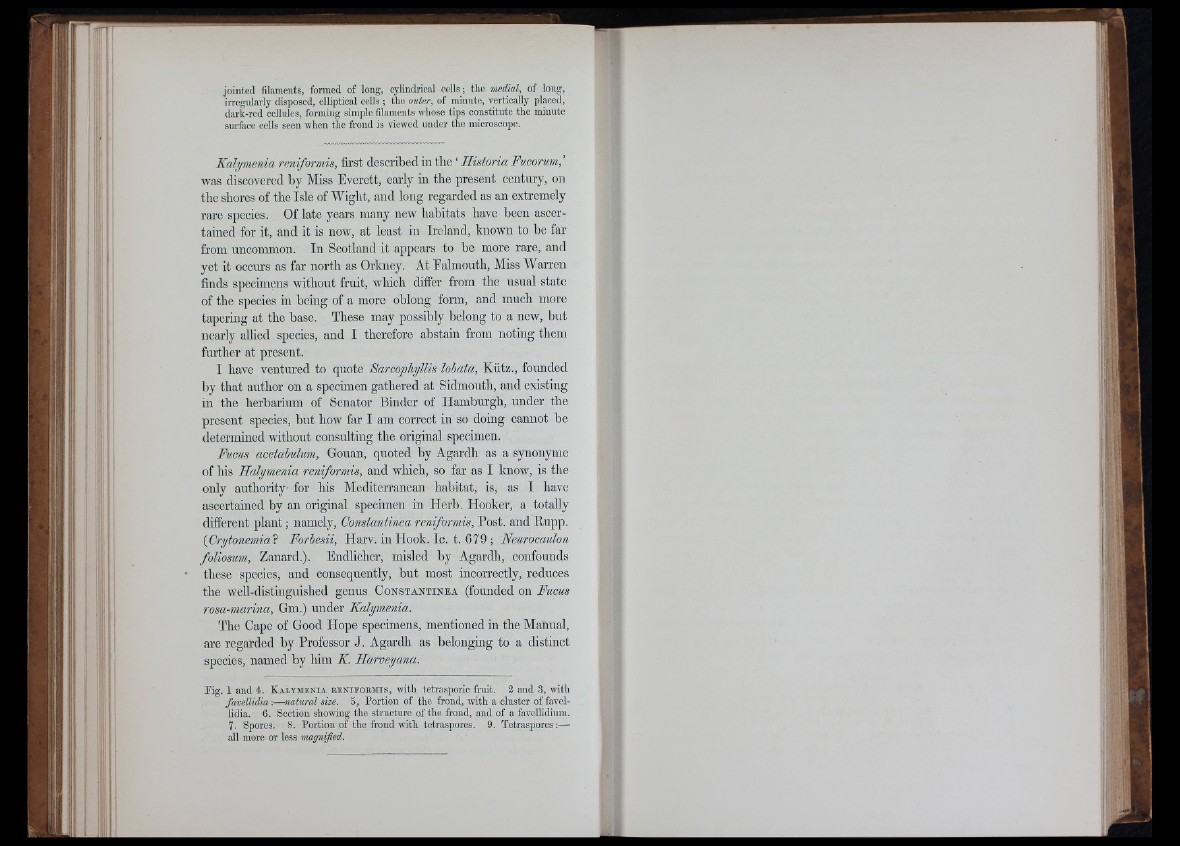
jointed filaments, formed of long, cylindrical cells; the medial, of long,
irregularly disposed, elliptical cells ; tlie outer, of minute, vertically placed,
dark-red cellules, forming simple filaments whose tips constitute the minute
surface cells seen when the frond is viewed under the microscope.
Kalymenia reniformis, first described in the ‘ Historia Fucorum.,’
was discovered by Miss Everett, early in the present century, on
the shores of the Isle of Wight, and long regarded as an extremely
rare species. Of late years many new habitats have been ascertained
for it, and it is now, at least in Ireland, known to be far
from uncommon. In Scotland it appears to be more rare, and
yet it occurs as far north as Orkney. At Ealmouth, Miss Warren
finds specimens without fruit, which differ from the usual state
of the species in being of a more oblong form, and much more
tapering at the base. These may possibly belong to a new, bnt
nearly allied species, and I therefore abstain from noting them
fiuther at present.
I have ventured to quote Sarcophjllis lobata, Kiitz., founded
by that author on a specimen gathered at Sidmouth, and existing
in the herbarium of Senator Binder of Hamburgh, under the
present species, but how far I am correct in so doing cannot be
determined without consulting the original specimen.
Fuais acetabulum, Gouan, quoted by Agardh as a synonyme
of his Halymenia reniformis, and which, so far as I know, is the
only authority' for his Mediterranean habitat, is, as I have
ascertained by an original specimen in Herb. Hooker, a totally
different plant; namely, Constantinea reniformis, Post, and Bupp.
(Crytonemia'i Forbesii, Harv. in Plook. Ic. t. 679 ; Neurocaulon
foliosum, Zanard.). Endlicher, misled by Agardh, confounds
these species, and consequently, but most incorrectly, reduces
tlie well-distingmshed genus C o n s t a n t in e a (founded on Fucus
rosa-marina, Gm.) under Kalymenia.
The Cape of Good Hope specimens, mentioned in the Manual,
are regarded by Professor J. Agardh as belonging to a distinct
species, named by him K. Harveyana.
Fig. 1 and 4. K a l y m e n ia r e n i f o r m i s , with tetrasporic fruit. 2 and 3, with
favellidia ■.— natural size. 5, Portion of the frond, with a cluster of favellidia.
6. Section showing the structure of the frond, and of a favellidium.
7. Spores. 8. Portion of the frond with tetraspores. 9. Tetraspores;—
aU more or less mag
111